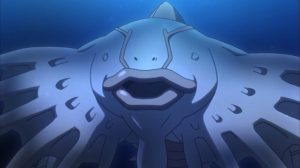 The thing about Seirei no Moribito is that it just has so many gears, so many levels. I don’t know of another anime that can succeed in so many different ways. There are long stretches in the first cour where you can forget altogether that this is fantasy, because there’s so much focus on character development and politics. But (probably not coincidentally) the start of the second half is when the main plot begins to assert itself in a big way, and the mythology becomes the primary plot driver.
The thing about Seirei no Moribito is that it just has so many gears, so many levels. I don’t know of another anime that can succeed in so many different ways. There are long stretches in the first cour where you can forget altogether that this is fantasy, because there’s so much focus on character development and politics. But (probably not coincidentally) the start of the second half is when the main plot begins to assert itself in a big way, and the mythology becomes the primary plot driver.
 Torogai is the unquestioned central focus of the first of these two episodes, but it’s also pretty much confirmed that it was the swordsmith’s spear blade that prevented Balsa from killing Karbo. Apparently, he did manage to create a blade to cut the bonds of Karma after all – and lucky for Balsa he did. But if there were any question of Balsa’s devotion to Chagum (and honestly, I don’t know why there would be) one can rest assured that she fully intended to kill Karbo – because that’s what she determined was necessary to protect Chagum. Chagum still feels guilty over what happened – not entirely without cause – but at least he doesn’t have the breaking of Balsa’s vow on his conscience.
Torogai is the unquestioned central focus of the first of these two episodes, but it’s also pretty much confirmed that it was the swordsmith’s spear blade that prevented Balsa from killing Karbo. Apparently, he did manage to create a blade to cut the bonds of Karma after all – and lucky for Balsa he did. But if there were any question of Balsa’s devotion to Chagum (and honestly, I don’t know why there would be) one can rest assured that she fully intended to kill Karbo – because that’s what she determined was necessary to protect Chagum. Chagum still feels guilty over what happened – not entirely without cause – but at least he doesn’t have the breaking of Balsa’s vow on his conscience.
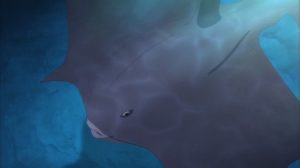 Meanwhile Shuga is also proving his devotion to Chagum in his own way. He’s secretly reading the secret texts – with the help of the door wardens, whose sympathies also lie with Chagum – trying to determine what’s really going on. All of them are taking an enormous risk here, defying the Holy Sage (whose name is Hibi Tonan apparently, which I confess I never knew before now). Shuga’s research eventually leads him to the same truth that Torogai is discovering with considerably more discomfort (and he gets to read some gorgeous scrolls in the process) but things soon take a very unsettling turn for him.
Meanwhile Shuga is also proving his devotion to Chagum in his own way. He’s secretly reading the secret texts – with the help of the door wardens, whose sympathies also lie with Chagum – trying to determine what’s really going on. All of them are taking an enormous risk here, defying the Holy Sage (whose name is Hibi Tonan apparently, which I confess I never knew before now). Shuga’s research eventually leads him to the same truth that Torogai is discovering with considerably more discomfort (and he gets to read some gorgeous scrolls in the process) but things soon take a very unsettling turn for him.
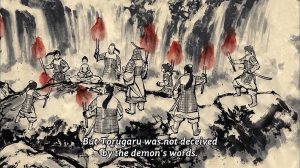 As for Torogai, her trip to the Knot has proved productive, and she’s learned some vital information from the Yona Ro Gai. To wit, the entire creation story of Shin Yogo is a lie, and the egg inside Chagum is not in fact a water demon, but a water spirit that will bring rain to Nayug and Sagu. That’s all well and good, but there’s some bad news to go along with it – the Rarunga, or Egg Eaters, are going to hunt down Chagum and kill him unless they’re stopped. At this point the water people flee danger and Torogai is left to try and find her way home, which proves a rather difficult matter.
As for Torogai, her trip to the Knot has proved productive, and she’s learned some vital information from the Yona Ro Gai. To wit, the entire creation story of Shin Yogo is a lie, and the egg inside Chagum is not in fact a water demon, but a water spirit that will bring rain to Nayug and Sagu. That’s all well and good, but there’s some bad news to go along with it – the Rarunga, or Egg Eaters, are going to hunt down Chagum and kill him unless they’re stopped. At this point the water people flee danger and Torogai is left to try and find her way home, which proves a rather difficult matter.
 This whole sequence has a lot of Ghibli to it, from the fire folk to the rushing river to Torogai offering up her rabbit-thingy to the stalactite worm about to eat her (he doesn’t forgive easily, either). Getting eaten by a worm in Nayug and pooped out in a tar pit in Sagu isn’t exactly flying first class, but it does get Torogai back to Chagum’s side – and it’s strongly implied that got some assistance from a sympathetic presence in Nayug in order to make it out alive.
This whole sequence has a lot of Ghibli to it, from the fire folk to the rushing river to Torogai offering up her rabbit-thingy to the stalactite worm about to eat her (he doesn’t forgive easily, either). Getting eaten by a worm in Nayug and pooped out in a tar pit in Sagu isn’t exactly flying first class, but it does get Torogai back to Chagum’s side – and it’s strongly implied that got some assistance from a sympathetic presence in Nayug in order to make it out alive.
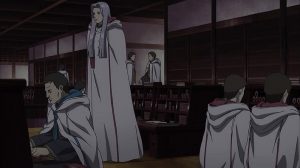 It’s at this point where if you listen really closely, you can hear my heart actually start to tear. I can’t fully divorce myself from what I know and remember exactly what I felt like when I watched Episode 15 the first time, but there’s such an air of melancholy to it. There are things which are unutterably sad in and of themselves, and others because of what we know is going to come. The use of background music is really exceptional here, especially the orchestral version of “Nahji no Uta” playing over the ep’s final scene. But I’ll get to that shortly.
It’s at this point where if you listen really closely, you can hear my heart actually start to tear. I can’t fully divorce myself from what I know and remember exactly what I felt like when I watched Episode 15 the first time, but there’s such an air of melancholy to it. There are things which are unutterably sad in and of themselves, and others because of what we know is going to come. The use of background music is really exceptional here, especially the orchestral version of “Nahji no Uta” playing over the ep’s final scene. But I’ll get to that shortly.
 There are also some lovely tender moments, like Torogai sending Chagum away to gather Yamabime so she can tell Balsa and Tanda the rest of what she learned at the Knot. Chagum is such a lovely soul, so innocent in spite of his worldliness – you can empathize with Balsa and Tanda’s growing desire to protect him from the cruelty of the world. And his eyes as he watches Torogai machine-gun yamabime seeds into the fire pit alone are worth the price of admission.
There are also some lovely tender moments, like Torogai sending Chagum away to gather Yamabime so she can tell Balsa and Tanda the rest of what she learned at the Knot. Chagum is such a lovely soul, so innocent in spite of his worldliness – you can empathize with Balsa and Tanda’s growing desire to protect him from the cruelty of the world. And his eyes as he watches Torogai machine-gun yamabime seeds into the fire pit alone are worth the price of admission.
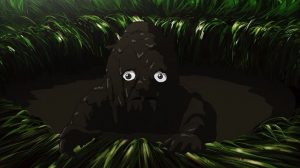 A plan is hatched – a trip to Toumi, a remote Yakue village where Tanda’s grandfather lived, which may preserve some knowledge of the old ways. And thus some of the truth that hasn’t been whitewashed by the Yogo. To Chagum this sounds like a grand adventure, but of course Balsa isn’t going to tell him the real reason for the trip until she absolutely has to. The merits of this can be debated, but while in general I believe in trusting children with the truth whenever possible, I think in this instance Balsa is probably right. What’s to be gained from terrifying Chagum and making him miserable at this point? He’s going to need all his mental strength for the struggle ahead (and Balsa doesn’t even know the half of it).
A plan is hatched – a trip to Toumi, a remote Yakue village where Tanda’s grandfather lived, which may preserve some knowledge of the old ways. And thus some of the truth that hasn’t been whitewashed by the Yogo. To Chagum this sounds like a grand adventure, but of course Balsa isn’t going to tell him the real reason for the trip until she absolutely has to. The merits of this can be debated, but while in general I believe in trusting children with the truth whenever possible, I think in this instance Balsa is probably right. What’s to be gained from terrifying Chagum and making him miserable at this point? He’s going to need all his mental strength for the struggle ahead (and Balsa doesn’t even know the half of it).
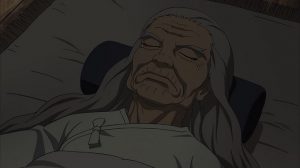 At the palace, Shuga has been freed through the heroic sacrifice of one of the door wardens, who loses his position (and possibly his life, though I hope not) when the Holy Sage learns the truth that the sanctum has been entered. He determines that Chagum is alive by observing the breast-like clouds the original Holy Sage Nanai refers to in his texts, and his first thought is to tell Sagum. But he doesn’t, because Sagum notes that it’s only the loss of Chagum that allows him to solider on in spite of his weariness. Sagum is smart – he knows that Chagum was the one who drew the long straw when it came to tutors, and he clearly knows Shuga is vital to the welfare of the empire going forward.
At the palace, Shuga has been freed through the heroic sacrifice of one of the door wardens, who loses his position (and possibly his life, though I hope not) when the Holy Sage learns the truth that the sanctum has been entered. He determines that Chagum is alive by observing the breast-like clouds the original Holy Sage Nanai refers to in his texts, and his first thought is to tell Sagum. But he doesn’t, because Sagum notes that it’s only the loss of Chagum that allows him to solider on in spite of his weariness. Sagum is smart – he knows that Chagum was the one who drew the long straw when it came to tutors, and he clearly knows Shuga is vital to the welfare of the empire going forward.
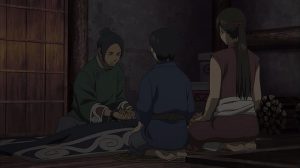 We didn’t see all that much of Sagum (though far more than in the books, where he barely appears except by name) but he made quite an impression. And he gets seriously one of the best death scenes of any character I know – it’s incredibly sad, probably even more because of the acceptance this youth has for his fate. Sagum knows Chagum was the one with the seeds of greatness in him, and that he could but try his best. But he always did that, and his last act is to free the nahji that he and Chagum nursed back to health (to the aforementioned background music). It soars free just as his soul does, but their freedom means the end of someone else’s.
We didn’t see all that much of Sagum (though far more than in the books, where he barely appears except by name) but he made quite an impression. And he gets seriously one of the best death scenes of any character I know – it’s incredibly sad, probably even more because of the acceptance this youth has for his fate. Sagum knows Chagum was the one with the seeds of greatness in him, and that he could but try his best. But he always did that, and his last act is to free the nahji that he and Chagum nursed back to health (to the aforementioned background music). It soars free just as his soul does, but their freedom means the end of someone else’s.
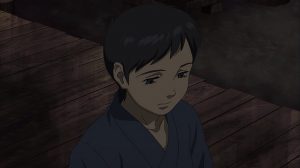 Sagum’s death is also, sadly, the end of Chagum’s chance for a happy life with Balsa and Tanda. When Chagum tells them how excited he is at the prospect of being free to live his life, it’s a terrible moment of foreshadowing even without foreknowledge. While Sagum lived Chagum was expendable to the Mikado – now, he’s indispensable. This would no doubt make Sagum, who loved seeing Chagum happy so much, very sad. And there’s a wonderful, heart-wrenching poetic symmetry to these events – Sagum’s passing , the nahji, and what it means for Chagum.
Sagum’s death is also, sadly, the end of Chagum’s chance for a happy life with Balsa and Tanda. When Chagum tells them how excited he is at the prospect of being free to live his life, it’s a terrible moment of foreshadowing even without foreknowledge. While Sagum lived Chagum was expendable to the Mikado – now, he’s indispensable. This would no doubt make Sagum, who loved seeing Chagum happy so much, very sad. And there’s a wonderful, heart-wrenching poetic symmetry to these events – Sagum’s passing , the nahji, and what it means for Chagum.


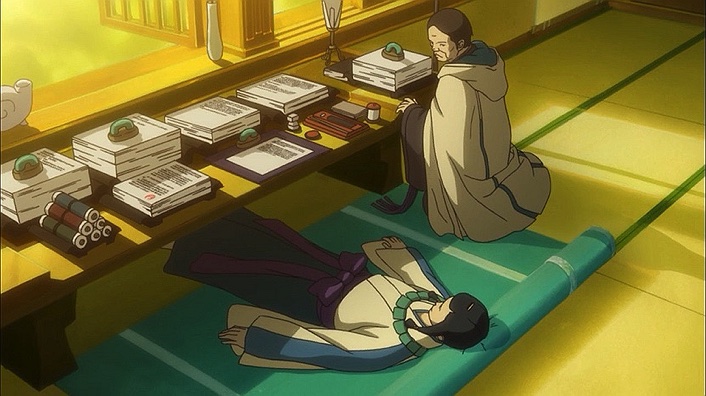
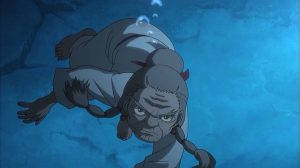
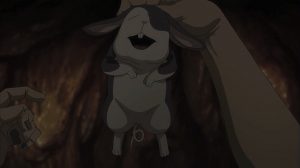
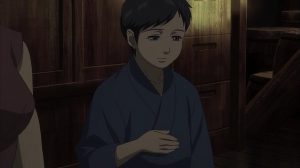

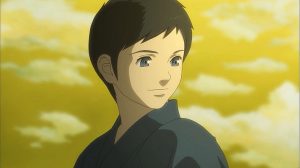
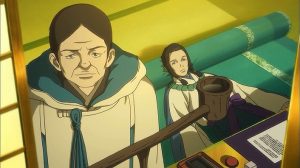

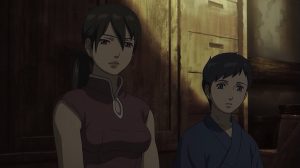

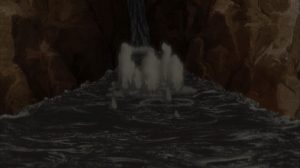
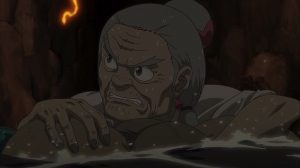
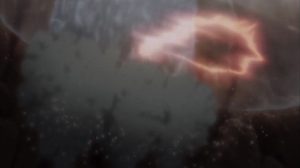

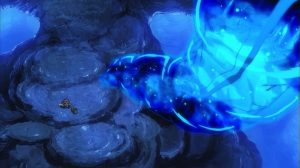
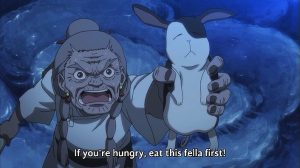
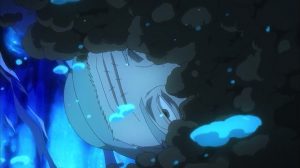
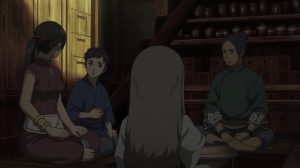
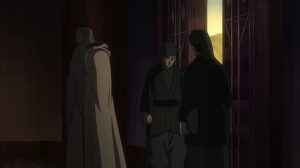
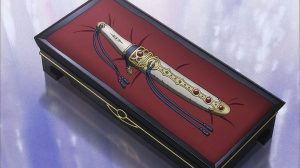
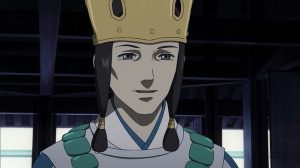
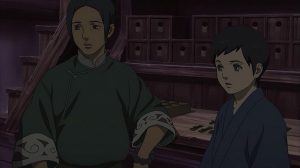
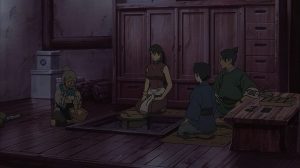
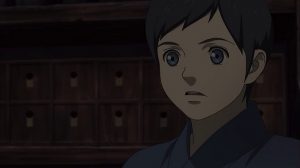
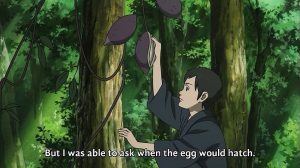
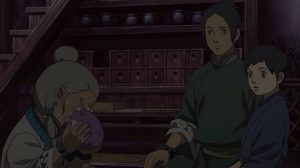
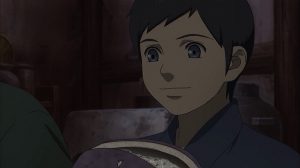
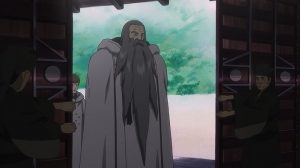


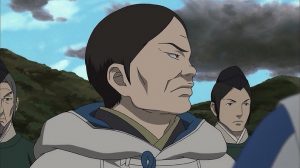


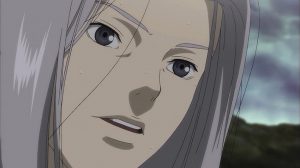
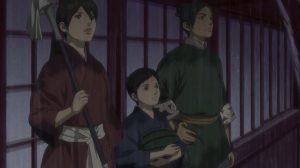
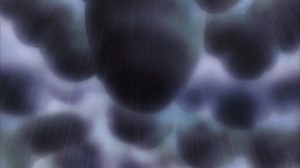
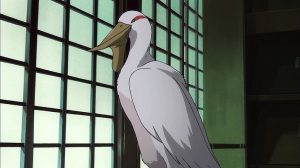
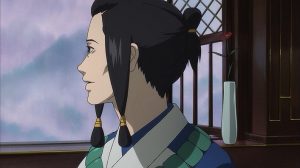
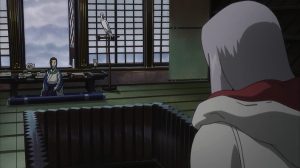

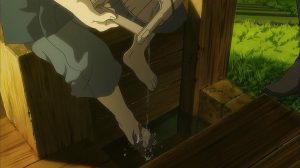
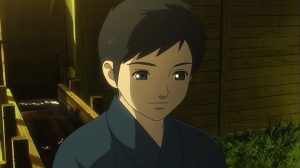
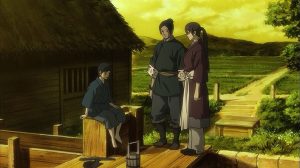
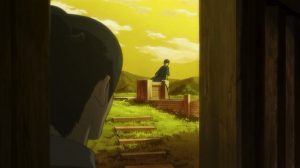
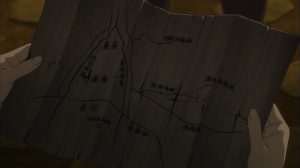
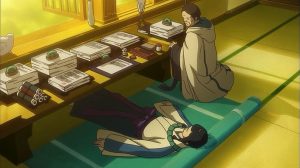
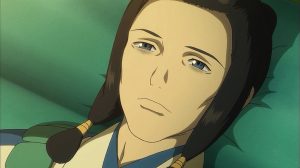
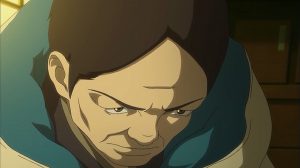
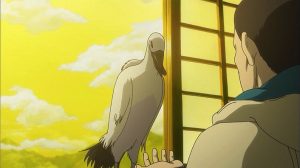
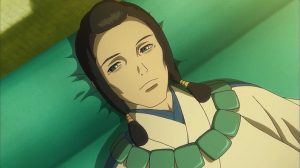
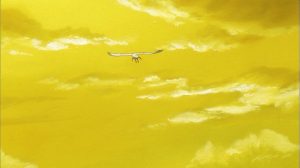
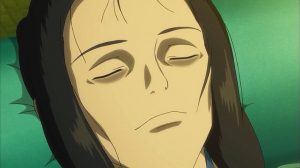
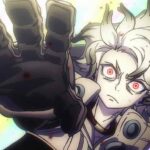
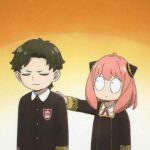
Panino Manino
June 24, 2020 at 9:12 amYes, Sagum’s death is one of the best death scenes, specially because they don’t use the cliché off making him die during the rain. On the contrary, he dies with the sun shining over him.
Would be better if Shuga had told him that Chagum is alive?
Would the desire to see his brother again keep Sagum alive?
Episode 14 is one that I dislike some bits.
It’s good that the anime expanded Balsa’s arc with Karbo, but then the second half of the story begins and all that is dropped. “Did I kill him… shouganai neeeeewait? Is that Torogai?!”. So sudden.
Did the sword smith created some “magic artifact”? Looks like Balsa is still totally willing to kill again to protect Chagum. While talking with Tanda about talking with Chagum about what they know she is polishing her spear. Would this now legendary blade do it’s trick again?